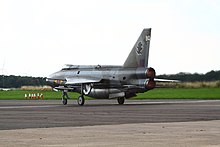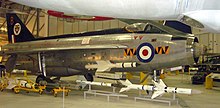Lightning XM135 flew on July 22, 1966
| Taffy Holden's unwanted Lightning flight | |
|---|---|
|
XM135 at the Imperial War Museum Duxford |
|
| Accident summary | |
| Accident type | Unintentional start during an engine test |
| place | RAF Lyneham |
| date | July 22, 1966 |
| Survivors | 1 (all) |
| Aircraft | |
| Aircraft type | English Electric Lightning F.1 |
| operator | RAF Maintenance Command |
| Mark | XM.135 |
| Departure airport | RAF Lyneham |
| Destination airport | RAF Lyneham |
| crew | 1 |
| Lists of aviation accidents | |
The flight of the Lightning XM135 on July 22, 1966 was unintentional. Walter "Taffy" Holden, an engineer at an RAF maintenance unit, turned off during engine tests which on the ground accidentally afterburner of a supersonic aircraft of the type English Electric Lightning one. Holden couldn't turn off the afterburners, so he rolled onto the runway , where he took off. Since he was flying without a radio and the ejection seat was deactivated, Holden had to land without outside help. On the third attempt to land, he lost the braking parachute , but was able to bring the machine to a standstill without major damage, although his limited flying experience was limited to single-engine training aircraft. The machine returned to service and was later acquired by the Imperial War Museum Duxford .
plane
The English Electric Lightning was a high-performance short-range interceptor. It had a maximum takeoff weight of 20 tons and could reach Mach 2.0. The aircraft involved in the incident was the second series Lightning and had the registration XM135. The aircraft had an electrical fault that only showed up during acceleration in the take-off phase. Due to a loose contact , the electrical inverter that supplied the flight instruments with power failed during the first few meters of the take-off run and the reserve inverter switched on.
crew
Wing Commander Walter "Taffy" Holden began his military service in 1943 and received a position as a cadet at a university. While studying mechanical engineering , Holden also learned to fly the Tiger Moth , a biplane. Holden pursued an engineering career with the RAF; However, the RAF qualified him after training on Harvard (North American T-6) with RAF Pilot Flying Badge ( s ) . He subsequently trained on the de Havilland Canada DHC-1 Chipmunk during his early career .
In 1966, Holden was in command of RAF Maintenance Unit No. 33 at RAF Lyneham Airfield , which was scheduled to be closed. The unit serviced Gloster Meteors , English Electric Canberras and English Electric Lightnings. At that time the unit was already disbanded and was about to hand over its last aircraft. The unit had a pilot for the Canberras and Meteors, but he was not qualified for the Lightning. For the verification flights, Holden had to locate RAF pilots with valid ratings, who could usually be found within 24 to 36 hours.
Flight history
Difficulties with the XM135 aircraft halted the unit's closure and at the time of the incident there was no Lightning pilot available for another week. An RAF Boscombe Down pilot who was involved in previous tests suggested that Holden conduct the check himself, as it only provided for rolling on the ground for 25 to 40 meters at a time. Each time he tried, Holden should test a different electrical configuration, rev up the engines to high speeds, then turn off the engines and apply the brakes. Holden was supposed to use a show of hands to communicate with his support crew who were coordinating the next test with the control tower.
Holden did not wear a helmet and had no radio. The hood of the aircraft was removed because electrical cables were led out of the cockpit. The landing gear was locked in the extended position because it was in ground mode.

After the Lightning was in position, Holden performed the initial check as expected and moved the aircraft 25-40 meters. In a subsequent test, however, he pushed the thrust lever past the afterburner position. As soon as the afterburners were switched on, he had to press the buttons behind the thrust levers to switch them off, but he had no experience in operating them. The machine quickly gained speed and narrowly missed a tanker truck that was crossing the train in front of it. The Lightning crossed the main runway, on which a de Havilland Comet was in the middle of the start, but already had sufficient height. When Holden reached the end of the runway, he pulled the stick back and took off.
Once launched, Holden managed to turn off the afterburners after feeling the buttons. He wondered if he should get out on the ejection seat. However, this was not possible because the ejection seat was locked in floor mode. On his first two landing attempts, his speed and altitude were incorrect and Holden abandoned the attempts. Holden, vaguely remembering that the Lightning was landing at 150 knots, made another lap around Lyneham and tried to land in the opposite direction of the runway so as not to approach the village. On his last attempt to land, he used the angle of attack of an airplane with a tail wheel due to his earlier training . This led to a tail strike on the rural railway, in which the rear rubber buffer of the Lightning hit the concrete, broke off and cut off the cable of the braking parachute, which served as a braking aid. By braking hard, Holden managed to bring the Lightning to a standstill about a hundred meters from the end of the runway. He was in the air for a total of 12 minutes.
Accident investigation
The plane was repaired and put back into service. During the investigation into the accident, it was found that the cause of the loose contact was the wiring that was left over from a removed floor test button on the reserve inverter. This created a short circuit with the grounded UHF radio device, which moved in its elastic suspension during the start-up process. After 1,343 flight hours, the XM135 was acquired by the Imperial War Museum Duxford in 1974, where it is on display.
The unintended flight could not be hidden from the press as the base was filled with civilian contractors. Holden was being sent to Italy on leave when the news broke; however, he was recognized there too. An investigation showed that Holden had not violated any regulations in the flight manual, which were changed a short time later. It also revealed that Holden had saved himself, the plane, and bystanders. According to Holden's notes, while investigating the incident, Air Marshal Kenneth Porter asked if he agreed that given his limited flying experience, he would have better left the test to an experienced Lightning pilot, to which Holden said yes. Porter then related some of his own unfortunate flight incidents.
Holden remained in the service of the RAF and retired around 1980. He died in 2016 at the age of 90.
Individual evidence
- ↑ a b c d e f g h Pilot by accident: The mechanic that took off in the world's strongest aircraft (Hebrew), Calcalist, Nitzan Sadan, April 5, 2019.
- ↑ a b c English Electric Lightning Mk I . Imperial War Museum .
- ^ A b c Empire of the Clouds: When Britain's Aircraft Ruled the World , James Hamilton-Paterson, pp. 223-225.
- ↑ a b c d e f g h A Memorable Fright , Walter Holden: The Wheel , reprinted from The Haltonian .
- ↑ a b c d e f English Electric / BAC Lightning Mks 1-6 , Kev Darling, pp. 56-57.
- ↑ Aircraft Illustrated Annual , I. Allan, 1980, p. 18.


